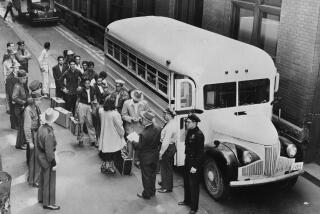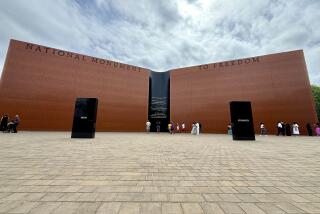Sculpture Rises as Work of Defiance
DETROIT — The steel arcs rising in a broken rainbow on the riverfront are meant to resemble giant gears bursting out of the earth. They honor the working-class men and women who built Detroit.
But the sculpture is not just about remembering. It’s a statement of defiance.
Unions represent only 13% of American workers these days -- the lowest level in six decades. The manufacturing jobs that traditionally have been the backbone of organized labor are vanishing, often going overseas. More than 2 million jobs disappeared in the last three years alone.
Yet unions around the world raised $1.5 million to build this sculpture in downtown Detroit. When completed next month, the Labor Legacy Landmark will be the Western Hemisphere’s largest tribute to workers.
To workers here, the project is a proud beacon. It is a symbol that organized labor will not fold, despite its weakness. And they hope it will inspire future generations of activists.
“Building a memorial on this scale says something about the energy, about the vitality of the labor movement today,” said Donald Boggs, president of the Metro Detroit AFL-CIO.
Others, though, see it as a eulogy.
“With the decline in union membership, there’s been a real emphasis on making sure that the stories [of the labor struggle] are shared with young people,” said John Revitte, a professor of labor history at Michigan State University. “It seems almost ironic.”
New York, Chicago, St. Louis and a number of other cities have begun promoting labor tourism, with guided trips to old factories, union halls and other historic sites. Museums are revising their exhibits on the Industrial Age to capture the stories not just of the great titans of industry, but also of the anonymous masses who toiled in filthy factories for as little as $2.34 a day. Even academics have begun to take the subject seriously; there’s now a national association of labor historians, Revitte said.
“The decline in manufacturing ... has meant that a way of life has disappeared,” said John Russo, director of the Center for Working Class Studies at Youngstown State University in Ohio. That loss, Russo said, has sparked a new interest in understanding workers: “Who were they? What happened when they were displaced?”
Detroit labor leaders plan to develop a school curriculum for field trips to the monument; they want to teach a new generation about the fight to win rights such as paid sick time and a 40-hour workweek. But they want the monument to be more than a history lesson.
In fact, they resist even calling it a monument.
“That word denotes the past. This is a forward-looking landmark, laying out labor’s vision for a better world,” said Dave Elsila, editor of Solidarity, the United Auto Workers magazine. “It’s about passing the torch, about learning from the past to create a better future.”
Artists David Barr and Sergio DiGuisti designed the 63-foot-high arch, which they call “Transcendence,” to be broken at the top. The open space, glinting in sunlight, represents the energy of workers everywhere -- and the unfinished struggle of the labor movement.
Below the stylized gears, 14 bronze sculptures on granite boulders will depict the toil of laborers past and present, from fur traders to airline pilots. The path that winds past the artwork will be engraved with quotations from labor leaders, politicians and civil rights activists.
From antislavery crusader Frederick Douglass: “If there is no struggle, there is no progress.”
From the placards of sawmill workers striking for a shorter workday: “Ten hours or no sawdust.”
From Cesar Chavez, who organized farm workers: “The people united will never be defeated.”
Mike Kerwin, 79, a retired autoworker, says it’s about time such sentiments were emblazoned on public art: “All the other monuments in this city honor politicians or generals. It was time to honor the everyday worker.”
Kerwin came up with the idea for a public tribute to labor several years ago, and is thrilled with the landmark. “It stands for the accomplishments of ordinary people just doing their thing,” he said.
The monument’s location reflects how important unions have been to the Motor City: It’s across the street from City Hall in downtown’s most bustling public space, Hart Plaza.
Michigan’s organized labor movement remains among the strongest in the country. With nearly 22% of its workers in unions, the state is tied with Alaska for third, behind only New York and Hawaii. (California ranks ninth, with 16% union membership, according to the U.S. Department of Labor.)
But to maintain its membership of about 180,000, the Metro Detroit AFL-CIO has to campaign constantly to recruit workers to replace those lost in factory layoffs. Local unions are trying to organize workers at Cintas Corp., one of the nation’s largest industrial laundries and uniform rental companies. They are also fighting for a toehold at Wal-Mart. And several unions -- notably the steelworkers and the Teamsters -- are trying to organize health-care professionals in nursing homes.
On a national level, Boggs noted that many of the goals organized labor achieved in generations past are now under threat, from overtime pay to health insurance to pensions.
“We’re hoping that the Labor Legacy Landmark will make people cognizant of how important unions are in everyday life,” Boggs said. “We’re hoping it will energize them to stay focused and keep pushing for their rights.”
More to Read
The biggest entertainment stories
Get our big stories about Hollywood, film, television, music, arts, culture and more right in your inbox as soon as they publish.
You may occasionally receive promotional content from the Los Angeles Times.










